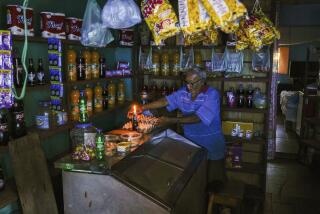Venezuela Strike Extended as Protesters, Troops Clash
- Share via
CARACAS, Venezuela — A nationwide strike against President Hugo Chavez will be prolonged into a third day after violence erupted between government forces and protesters Tuesday.
National guard troops launched tear gas and fired rubber pellets at demonstrators during a rolling protest around the financial center of the state oil company, PDVSA.
The troops’ action came as the strike seemed to be losing force, and provided new energy to the protest. Opposition leaders called for a massive march today to force Chavez to agree to a referendum on his rule.
“The repression against Venezuelans who were protesting pacifically ... proves the unpopular, anti-democratic and repressive nature of this regime,” said Carlos Ortega, the head of the country’s largest union. “Today, more than ever, the strike goes on.”
But Chavez said the opposition was trying to provoke a confrontation similar to the one in April when he was briefly deposed.
Venezuela’s crisis pits Chavez against a coalition that includes unions, businesses and the media, who accuse the controversial president of leading the country into social chaos and financial ruin.
“There is no strike. The country is working,” Chavez said, speaking to reporters outside the presidential palace. “They have decided to extend what they call a strike because they’re looking for destabilization.... They have begun to provoke acts of violence.”
The call to continue the protest raised fears that the strike could begin to affect oil production, which in the past has proved a catalyst for violence. Venezuela is the third-largest supplier of oil to the United States, and petroleum accounts for more than half the government revenue.
A prolonged strike backed by petroleum workers in April led to the coup that overthrew Chavez. He was returned to power 48 hours later by loyal troops and supporters.
There were conflicting reports Tuesday of how the oil industry had been affected by the current strike. PDVSA executives said that as many as 90% of white-collar workers and 65% of blue-collar workers were on strike.
But government officials said that contingency plans were allowing normal functioning at most production sites.
They said 89% of workers showed up for their jobs Tuesday.
On world markets, the price of Venezuelan oil rose slightly to $26.03 a barrel Tuesday, though it fell in after-hours trading.
“There have been no problems with gas or [oil] production,” said Maria Cristina Iglesia, the labor minister.
Acknowledging a dip in support from the 80% participation it claimed Monday, the opposition said 75% of the country heeded the call to strike.
On the streets Tuesday, traffic was still light, but there were far more cars on the roads and shops open than on Monday.
In the poorer, western and central parts of Caracas, the capital, where Chavez draws much of his support, business seemed to have returned almost to normal.
Even in the heart of the opposition, shops opened.
“I don’t see as there is any sense or logic in a strike,” said Juan Carlos Nino, 28, who runs a small restaurant a block from a plaza in a wealthy eastern neighborhood that has been a center of opposition protests.
Oil is a source of national pride and wealth, and it played a key role in Tuesday’s protests.
Early Tuesday morning, PDVSA’s director of planning, Juan Fernandez, called police to report that his home had been broken into and that masked men had held a gun to his head and threatened to kill him.
Police made no arrests, but Fernandez made clear Tuesday that he suspected that Chavez supporters could have been behind the break-in.
“I’m not saying who is guilty,” he said in an interview. “But it’s very strange.”
The attack against Fernandez, as well as the government’s detention of two oil executives who allegedly had blocked workers from going to their jobs, led to a gathering of protesters in front of PDVSA’s financial headquarters Tuesday afternoon.
Hundreds of troops in gas masks and camouflage suddenly appeared marching in tight ranks under the warm sun and blue skies.
Without warning, they fired tear gas into the crowd of nearly 1,000 people, who scattered in all directions.
Soldiers in armored personnel carriers raced around the complex, surrounding protesters and firing gas canisters. Some fleeing protesters were beaten with flat metal swords that the troops used for crowd control.
“This was a provocation by the government,” said Edgar Bond, a PDVSA manager who was fleeing the protest, his eyes red from the gas. “The government wants to seek a solution by force.”
Opposition protesters regrouped throughout the day at different sites, blocking highways, waving flags and playing a cat-and-mouse game with the national guard, who repeatedly pushed back the crowd with tear gas.
The action on the street Tuesday overshadowed a development that promised to relieve tensions in the deeply divided country.
The opposition is striking to force Chavez to hold a referendum on his rule early next year.
The National Electoral Council reviewed about 2 million signatures collected by the opposition and approved the referendum by a 3-1 vote. But last week, its decision was overturned by the Supreme Court, which ruled that the referendum had to be approved by at least four of the council’s five members.
On Tuesday, however, the council’s president, Alfredo Avella, announced that the council had arrived at the four votes necessary to go ahead with the referendum. A council member who had previously abstained cast the deciding vote.
Chavez has said a referendum on his rule is not constitutionally allowed until he has completed half of his term, in August next year.
More to Read
Sign up for Essential California
The most important California stories and recommendations in your inbox every morning.
You may occasionally receive promotional content from the Los Angeles Times.










